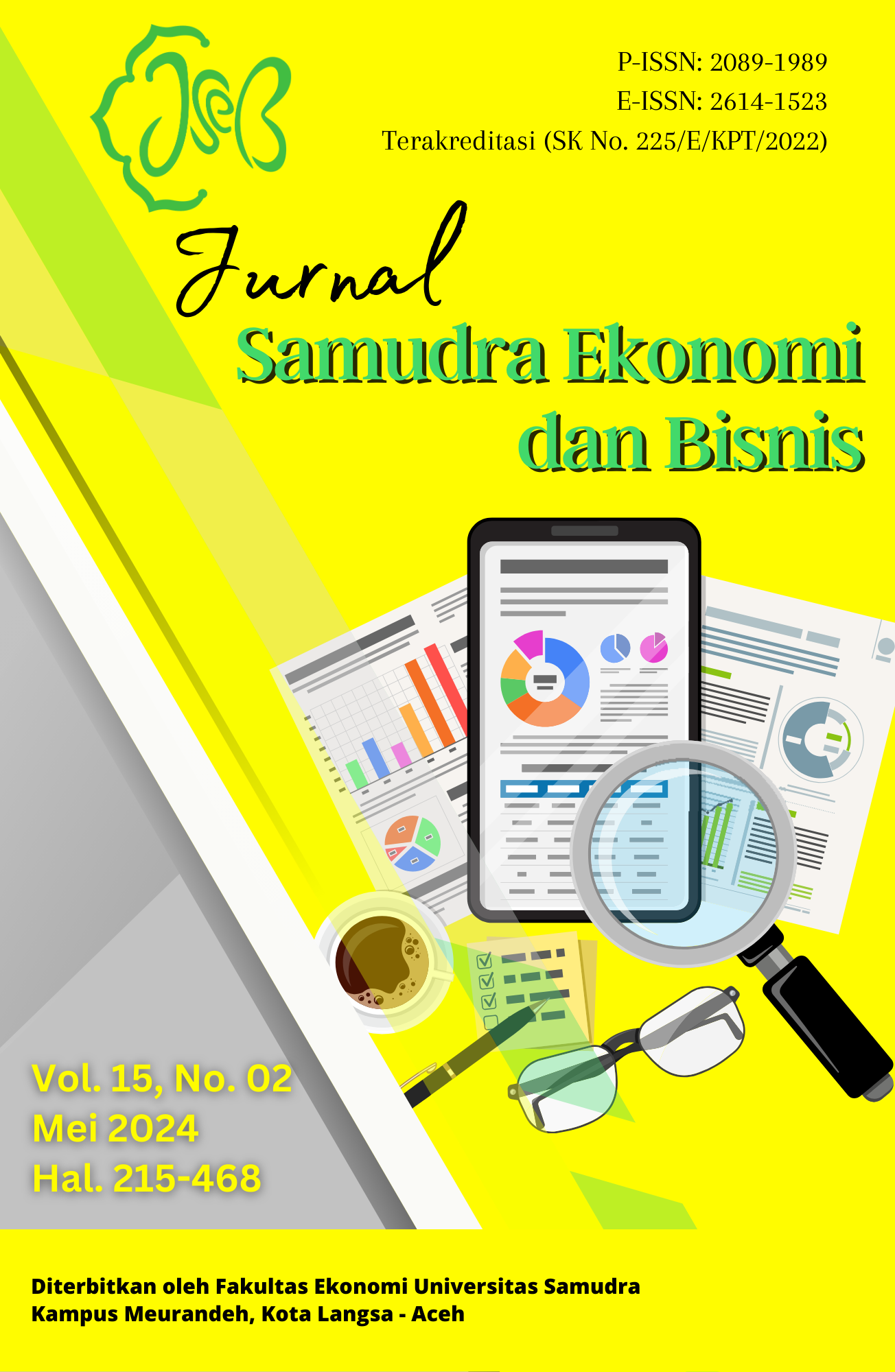Pengaruh E-Commerce Marketing Stimuli terhadap Trust, Customer Satisfaction, dan Customer Loyalty
Abstract
Consumer behavior conceptually begins with marketing stimuli which then ends with purchasing decisions. This research analyzes the influence of e-service quality, reputation, web design and price on trust, customer satisfaction and customer loyalty. Survey data from 370 respondents obtained through an online questionnaire was then processed using structural equation modeling (SEM). The results of this research show that e-service quality, trust, and price influence customer satisfaction. Furthermore, if e-commerce can respond to customer complaints and provide services that are personally tailored to meet customer needs, customer satisfaction will be created.
References
Abumalloh, R. A., Ibrahim, O., & Nilashi, M. (2020). Loyalty of young female Arabic customers towards recommendation agents: A new model for B2C E-commerce. Technology in Society, 61(5), 101253. https://doi.org/10.1016/j.techsoc.2020.101253.
Afrianto, A. P., & Irwansyah, I. (2021). Eksplorasi kondisi masyarakat dalam memilih belanja online melalui Shopee selama masa pandemi Covid-19 di Indonesia. Jurnal Teknologi Dan Sistem Informasi Bisnis, 3(1), 10–29. https://doi.org/10.47233/jteksis.v3i1.181.
Al-Adwan, A. S., & Al-Horani, M. A. (2019). Boosting customer e-loyalty: An extended scale of online service quality. Information, 10(12), 380. https://doi.org/10.3390/info10120380.
Alkhurshan, M., & Rjoub, H. (2020). The scope of an integrated analysis of trust switching barriers, customer satisfaction and loyalty. Journal of Competitiveness, 12(2), 5–21. https://doi.org/10.7441/joc.2020.02.01.
Alwi, I. (2015). Kriteria empirik dalam menentukan ukuran sampel pada pengujian hipotesis statistika dan analisis butir. Formatif: Jurnal Ilmiah Pendidikan MIPA, 2(2), 140–148. https://doi.org/10.30998/formatif.v2i2.95.
Anderson, R. E., & Srinivasan, S. S. (2003). E‐satisfaction and e‐loyalty: A contingency framework. Psychology & Marketing, 20(2), 123–138. https://doi.org/10.1002/mar.10063.
Aparicio, M., Costa, C. J., & Moises, R. (2021). Gamification and reputation: Key determinants of e-commerce usage and repurchase intention. Heliyon, 7(3), e06383. https://doi.org/10.1016/j.heliyon.2021.e06383.
Attar, R. W., Shanmugam, M., & Hajli, N. (2021). Investigating the antecedents of e-commerce satisfaction in social commerce context. British Food Journal, 123(3), 849–868. https://doi.org/10.1108/BFJ-08-2020-0755.
Blut, M. (2016). E-service quality: Development of a hierarchical model. Journal of Retailing, 92(4), 500–517. https://doi.org/10.1016/j.jretai.2016.09.002.
Bobalca, C. S., Ţugulea, O., Ifrim, M., & Maha, L.-G. (2021). Analysing the predictors of the young buyers’ satisfaction in the e-retailing apparel sector. International Journal of Retail & Distribution Management, 49(12), 1597–1620. https://doi.org/10.1108/IJRDM-08-2020-0302.
Casaló, L., Flavián, C., & Guinalíu, M. (2007). The impact of participation in virtual brand communities on consumer trust and loyalty: The case of free software. Online Information Review, 31(6), 775–792. https://doi.org/10.1108/14684520710841766.
Ciputra, W., & Prasetya, W. (2020). Analisis pengaruh e-service quality, perceived value terhadap customer satisfaction, trust, dan customer behavioral intention: Survei pada customer toko online www.blibli.com. COMMENTATE: Journal of Communication Management, 1(2), 109–128. https://doi.org/10.37535/103001220201.
Collier, J. E., & Bienstock, C. C. (2006). Measuring service quality in e-retailing. Journal of Service Research, 8(3), 260–275. https://doi.org/10.1177/1094670505278867.
Das, S. R. (2019). The future of fintech. Financial Management, 48(4), 981–1007. https://doi.org/10.1111/fima.12297.
Deng, L., & Poole, M. S. (2012). Aesthetic design of e-commerce web pages – Webpage complexity, order and preference. Electronic Commerce Research and Applications, 11(4), 420–440. https://doi.org/10.1016/j.elerap.2012.06.004.
Faraoni, M., Rialti, R., Zollo, L., & Pellicelli, A. C. (2019). Exploring e-loyalty antecedents in B2C e-commerce: Empirical results from Italian grocery retailers. British Food Journal, 121(2), 574–589. https://doi.org/10.1108/BFJ-04-2018-0216.
Gunawan, I. (2016). Metode penelitian kuantitatif. Bumi Aksara.
Ighomereho, S. O., Ojo, A. A., Omoyele, S. O., & Olabode, S. O. (2022). From service quality to e-service quality: Measurement, dimensions and model. Papers 2205.00055, arXiv.org. https://doi.org/10.48550/arXiv.2205.00055.
Kassim, N., & Abdullah, N. A. (2010). The effect of perceived service quality dimensions on customer satisfaction, trust, and loyalty in e‐commerce settings: A cross cultural analysis. Asia Pacific Journal of Marketing and Logistics, 22(3), 351–371. https://doi.org/10.1108/13555851011062269.
Khaliq, R. (2019). Pengaruh kualitas pelayanan terhadap kepuasan nasabah Bank Syariah Mandiri di Banjarmasin Kalimantan Selatan. Relevance: Journal of Management and Business, 2(1), 177-188. https://doi.org/10.22515/relevance.v2i1.1609.
Khan, R. U., Salamzadeh, Y., Iqbal, Q., & Yang, S. (2022). The impact of customer relationship management and company reputation on customer loyalty: The mediating role of customer satisfaction. Journal of Relationship Marketing, 21(1), 1–26. https://doi.org/10.1080/15332667.2020.1840904.
Kimathi, F. A., & Zhang, Y. (2019). Exploring the general extended technology acceptance model for e-learning approach on student’s usage intention on e-learning system in University of Dar es Salaam. Creative Education, 10(1), 208–223. https://doi.org/10.4236/ce.2019.101017.
Lee, G., & Lin, H. (2005). Customer perceptions of e‐service quality in online shopping. International Journal of Retail & Distribution Management, 33(2), 161–176. https://doi.org/10.1108/09590550510581485.
Lestari, F. A. P. (2018). Pengaruh web e-commerce, kualitas produk dan kualitas layanan terhadap kepuasan konsumen. Sosio E-Kons, 10(1), 87–95. https://doi.org/10.30998/sosioekons.v10i1.2411.
Lin, X., Wang, X., & Hajli, N. (2019). Building e-commerce satisfaction and boosting sales: The role of social commerce trust and its antecedents. International Journal of Electronic Commerce, 23(3), 328–363. https://doi.org/10.1080/10864415.2019.1619907.
Malhotra, N. K. (2020). Marketing research: An applied orientation. Pearson.
Marcos, A. M. B. de F., & Coelho, A. F. de M. (2022). Service quality, customer satisfaction and customer value: Holistic determinants of loyalty and word-of-mouth in services. The TQM Journal, 34(5), 957–978. https://doi.org/10.1108/TQM-10-2020-0236.
Marwiyah, S. L., Ainulyaqin, M. H., & Edy, S. (2023). Analisis pengaruh perilaku konsumtif dan tingkat pendapatan terhadap online shopping pada e-commerce Shopee dalam perspektif ekonomi Islam. Jurnal Ilmiah Ekonomi Islam, 9(3), 3406–3413. https://doi.org/10.29040/jiei.v9i3.10783.
Meilatinova, N. (2021). Social commerce: Factors affecting customer repurchase and word-of-mouth intentions. International Journal of Information Management, 57(4), 102300. https://doi.org/10.1016/j.ijinfomgt.2020.102300.
Nofrizal, N., Sucherly, S., Juju, U., Khairani, Z., Soviyanti, E., Hadiyati, H., & Arizal, N. (2023). Can product quality improve purchase decisions in e-commerce and social media through customer loyalty and trust? Binus Business Review, 14(2), 147–161. https://doi.org/10.21512/bbr.v14i2.8800.
Omar, N. A., Nazri, M. A., Ali, M. H., & Alam, S. S. (2021). The panic buying behavior of consumers during the Covid-19 pandemic: Examining the influences of uncertainty, perceptions of severity, perceptions of scarcity, and anxiety. Journal of Retailing and Consumer Services, 62(10), 102600. https://doi.org/10.1016/j.jretconser.2021.102600.
Peiris, P. M., Kulkarni, D., & de Silva Mawatha, C. R. (2015). An empirical study of customer adoption of e-commerce: A customer trust model to support the adoption of e-commerce among small-and medium-sized enterprises in Sri Lanka. International Journal of Business and Information, 10(4), 491-518. http://dx.doi.org/10.6702/ijbi.2015.10.4.4.
Pink, B. (2021, October 21). Minat belanja online naik, BI optimistis nilai transaksi e-commerce tumbuh 48,4%. www.kontan.co.id.
Prasetyo, A. N., & Yusran, H. L. (2022). Pengaruh e-service quality dan e-trust terhadap repurchase intention melalui e-satisfaction pada pengguna e-commerce. International Journal of Demos, 4(1), 137-151. https://doi.org/10.37950/ijd.v4i1.193.
Prayogo, M. A., & Setyawan, A. A. (2023). Pengaruh perceived credibility, perceived reputation, dan brand trust terhadap brand loyalty pada pengguna smartphone. Journal of Economics Business Finance and Accounting, 1(1), 17–30. http://journal.mrcrizquna.com/index.php/jebfa/article/view/49.
Rahi, S., Ghani, M. A., & Ngah, A. H. (2020). Factors propelling the adoption of internet banking: the role of e-customer service, website design, brand image and customer satisfaction. International Journal of Business Information Systems, 33(4), 549–569. https://doi.org/10.1504/IJBIS.2020.105870.
Ramadan, Z., Farah, M., Abosag, I., & Sleiman, A. (2023). Typology of e-commerce shoppers: The case of COVID-19. Qualitative Market Research: An International Journal, 26(4), 345–367. https://doi.org/10.1108/QMR-12-2021-0154.
Raza, S. A., Umer, A., Qureshi, M. A., & Dahri, A. S. (2020). Internet banking service quality, e-customer satisfaction and loyalty: The modified e-SERVQUAL model. The TQM Journal, 32(6), 1443–1466. https://doi.org/10.1108/TQM-02-2020-0019.
Rialti, R., Pellegrini, M. M., Caputo, A., & Dabic, M. (2017). Entrepreneurial education and internationalisation of firms in transition economies: A conceptual framework from the case of Croatia. World Review of Entrepreneurship, Management and Sustainable Development, 13(2–3), 290–313. https://doi.org/10.1504/WREMSD.2017.083027.
Rita, P., Oliveira, T., & Farisa, A. (2019). The impact of e-service quality and customer satisfaction on customer behavior in online shopping. Heliyon, 5(10), e02690. https://doi.org/10.1016/j.heliyon.2019.e02690.
Rodríguez, P. G., Villarreal, R., Valiño, P. C., & Blozis, S. (2020). A PLS-SEM approach to understanding E-SQ, e-satisfaction and e-loyalty for fashion e-retailers in Spain. Journal of Retailing and Consumer Services, 57(11), 102201. https://doi.org/10.1016/j.jretconser.2020.102201.
Saragih, M. G. (2019). Pengaruh e-service quality terhadap e-loyalty melalui e-satisfaction (Studi pada pelanggan toko online Shopee di Kota Medan). Jurnal Mantik, 3(1), 190–195. http://iocscience.org/ejournal/index.php/mantik/article/view/141.
Setyowati, D., & Suryoko, S. (2020). Pengaruh e-service quality terhadap keputusan pembelian melalui e-trust sebagai variabel mediasi (Studi pada pengguna situs Bukalapak di Kota Semarang). Jurnal Ilmu Administrasi Bisnis, 9(1), 251–260. https://doi.org/10.14710/jiab.2020.26331.
Sihaloho, E. H. (2023). Pengaruh web-design, e-service quality dan brand impression terhadap keputusan pembelian di Yogyakarta (Studi kasus website Tokopedia). Publikasi Ilmiah. STIE YKPN Yogyakarta. http://repositorybaru.stieykpn.ac.id/1337/.
Suhaily, L., & Soelasih, Y. (2017). What effects repurchase intention of online shopping. International Business Research, 10(12), 113–122. https://doi.org/10.5539/ibr.v10n12p113.
Syuhada, A. A., & Gambett, W. (2013). Online marketplace for Indonesian micro small and medium enterprises based on social media. Procedia Technology, 11, 446–454. https://doi.org/10.1016/j.protcy.2013.12.214.
Uzir, M. U. H., Al Halbusi, H., Thurasamy, R., Hock, R. L. T., Aljaberi, M. A., Hasan, N., & Hamid, M. (2021). The effects of service quality, perceived value and trust in home delivery service personnel on customer satisfaction: Evidence from a developing country. Journal of Retailing and Consumer Services, 63, 102721. https://doi.org/10.1016/j.jretconser.2021.102721.
Venkatakrishnan, J., Alagiriswamy, R., & Parayitam, S. (2023). Web design and trust as moderators in the relationship between e-service quality, customer satisfaction and customer loyalty. The TQM Journal, 35(1), 2455–2484. https://doi.org/10.1108/TQM-10-2022-0298.
Wicaksono, Y., & Santoso, S. B. (2015). Pengaruh kualitas pelayanan dan kepercayaan terhadap loyalitas pelanggan dengan kepuasan pelanggan sebagai variabel intervening (Studi pelanggan di PT. Indo Samudera Perkasa Semarang). Diponegoro Journal of Management, 4(4), 428-438. https://ejournal3.undip.ac.id/index.php/djom/article/view/13349/12906.
Wirapraja, A., Aribowo, H., & Setyoadi, E. T. (2021). The influence of e-service quality, and customer satisfaction on Go-Send customer loyalty in Surabaya. Indonesian Journal of Information Systems, 3(2), 128–137. http://repository.ikado.ac.id/152/.
Yasri, Y., Susanto, P., Hoque, M. E., & Gusti, M. A. (2020). Price perception and price appearance on repurchase intention of Gen Y: Do brand experience and brand preference mediate? Heliyon, 6(11), e05532. https://doi.org/10.1016/j.heliyon.2020.e05532.
Copyright (c) 2024 Maraya Sakinah, Ignatius Heruwasto

This work is licensed under a Creative Commons Attribution-ShareAlike 4.0 International License.


















